#sailing – With all the high-profile Irish entries in the RORC Caribbean 600 race falling by the wayside in this year's breezy staging of the sunshine classic, it has been left to two hard-working charter boats to do the business for Ireland, and they've done us proud.
Appropriately, both boats are owned by people who are involved with the wind energy business. The bigger of the two, the Farr-designed 100ft Cape Arrow which has placed 13th overall, is owned and managed by Tuskar Shipping, which is in turn owned by Fastnet Shipping, a Waterford company which is run by Sinead and Trevor O'Hanlon and specialises in servicing the offshore wind industry.
Cape Arrow is professionally skippered by Andrea Balzarini. But the other Irish front runner, the 76ft Lilla which has won Class 1 and placed 8th overall, has owner Simon de Pietro of Kinsale YC very much hands-on as skipper, while his wife Nancy is the navigator. They demonstrated their joint skills last year by winning overall in the cruiser division in the biennial Newport-Bermuda Race, but this time round they'd their boat going so well they had the class win in the open division.
Both of them maintain close ties with Ireland. Her people are from Sligo, while his mother lives near Buttevant in County Cork and is co-director of the Buttevant-based family firm, DP Energy. The company is in the forefront of wind harnessing technology, and is also at the heart of the major project to install a huge tidal farm with multiple turbines in the ferocious streams which run off Islay in the southwest Scottish Hebrides, with the turbines being serviced from Northern Ireland.
That particular challenge would be enough for most people, but as well they manage Lilla as an active charter boat, fitting their occasional races around an active working programme when the boat is skippered in choice cruising locations by Ian Martin. It's a busy life, and there's extra interest in that Lilla is now something of a classic – she was built in Bordeaux in 1993 in aluminium to a Philipppe Briand design. Thus the win in Class 1 in the Caribbean 600 made for a nice 20th birthday present for a boat which is still as good as new, and very elegant with it.
The annual sprint around the islands with the Caribbean 600 provides an opportunity for some of the biggest sailing charter boats to show how they can go like the clappers if given the chance, and it provided some intriguing results even if the prime positions were largely as predicted. Thus the line honours winner as expected was Mike Slade's 100ft Leopard, though she was five hours outside the record time set by George David's Rambler 100 in 2011, which was a decidedly mixed year for that big boat, as by mid-August she was upside down off Barley Cove with her keel gone AWOL in the Fastnet Race.
On corrected time, again as expected it was a battle between Hap Fauth's Judel Vrolik 72 Bella Mente and Ron O'Hanley's Cookson 50 Privateer, with the latter having a well-deserved win by 22 minutes. So that's all right, then. But maybe the real story is when we delve into the other boat times, and note that the schooner Adela placed third overall on IRC, and finished just half an hour after the out-and-out racing machine Privateer.
Adela is a massively big - as in enormous - 180ft steel-built schooner, designed by Djikstra and built by Pendennis in Falmouth in 1995. To blast round the course in a machine like this in a way which enables her to sail up to her rating with such impressive style is just a fantastic achievement by skipper Greg Perkins.
Admittedly when you see Adela out of the water, it's to realize she's not so much a wolf in sheep's clothing as a cheetah in haute couture. Above the waterline, she's all sweeping counter and elegant clipper bow, but below it she's a workmanlike fin and skeg profile which really does give her performance a lot of oomph.
Even so, the loads which a boat this size imposes on her sails, rig and equipment is something which can only be partially measured electronically. There's a huge element of experienced judgment in driving her to the limit without seriously breaking something, and to do it round a course like this which involves frequent directional changes shows skill of a very high order. So let's hear it for the big steel lady.
And spare a thought for those who dropped out. The 100ft Liara skippered by Peter Metcalf from Northern Ireland hadn't got very far from the breezy start when her mast came down, while damage to both the 78ft Whisper (Mark Dicker) and the First 40 Lancelot II (Michael Boyd, Niall Dowling and John Cunningham) likewise saw them under the DNF category. As for the storm-battered Irish-owned Swan 48 Wolfhound which was registered DNS, she may still be out there somewhere around 70 miles north of Bermuda. Her crew were taken off in a severe storm by a ship which heard their EPIRB, but when last seen in atrocious sea conditions, Wolfhound was still afloat.
BERMUDA RIG IS FOR WIMPS
Those crusty old Dublin Bay salts who have been dumping big time on this blog for our enthusiasm for the Dublin Bay 21s in their original gaff-rigged form, bashing us with their negative memories of near-sinkings and actual sinkings and hellships that generated lee helm when the mainsheet was let fly in strong winds, they may well think we've retired hurt from the fray. Not a bit of it. We've only been re-arming. Now we'll let them have it with both barrels.
What on earth do they think the original owners had in mind when they ordered the boats in the first place? Were they looking for comfortable little cruisers to doddle around the bay? Not a bit of it. They were looking for boats suitable for wild sportsmen, not for boats approved of by conservative seaman.
Of course the Dublin Bay 21s were demanding and difficult and sometimes dangerous to sail. That was what it was all about. There's no sport in safety. And of course they were hard work, and an ergonomic disaster area in terms of ease of handling. That's the way life was in 1902, and the ways of the sea were supposed to be harder than the cosseted life ashore. So let's take a look at another photo of a Dublin Bay 21 under her original gaff rig with jackyard tops'l, and see why they represented such an awful but irresistible challenge.
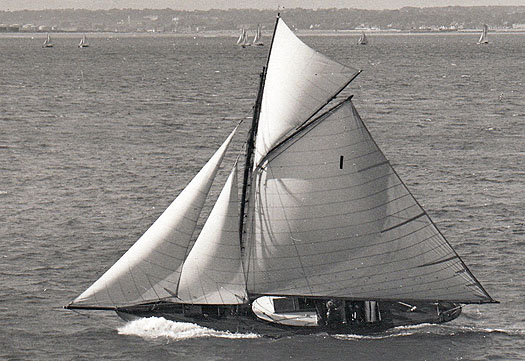
In steady conditions, the Dublin Bay 21 under full sail was manageable, but she provided a real challenge when sailed hard in a blow.
The photo must have been taken in the late 50s, with the boat setting what was to become her last suit of gaff sails. Though they're bearing up reasonably well, a certain bagginess would exacerbate any helming faults. The tiller is well across, suggesting marked weather helm, but don't forget the rudder was well raked, which exaggerated the appearance of the amount of helm necessary, and as the boats aged there was increasing flexibility – to put it mildly - in the connection between rudderhead and tiller.
Thus basically the boat is quite reasonably well balanced. But imagine what happens if a sudden squall strikes. As our old salts have pointed out, the narrow side deck means that the Dublin Bay 21s start to fill with Dublin Bay through the non-self-draining cockpit quite quickly. The mainsheet must be eased as quickly as possible. The ergonomics are terrible, with the mainsheet controlled from cleats outside the cockpit coaming, so a lot of the time in a sudden wind increase the mainsheet – with its tails in a jumble below – is simply let fly, thereby immediately and completely altering the balance of the boat. It would defy all the laws of centre of effort and centre of lateral resistance if she didn't suddenly develop marked lee helm.
So the skill lay in controlling the easing of the mainsheet, one helluva challenge when you're up to your armpits in the cold ocean in ancient oilskins, and everyone is falling over everyone else. And as for suggesting the side-decks should be made wider, that would only make the cramped cockpit even more crowded. But with a skilled helmsman and an even more skilled mainsheet man, preferably of superhuman strength, it could be kept under control, for basically as our second picture shows, it wasn't an inherent fault in the shape of the boat which caused wild fluctuations in balance, but rather a severe temporary imbalance of the sails.
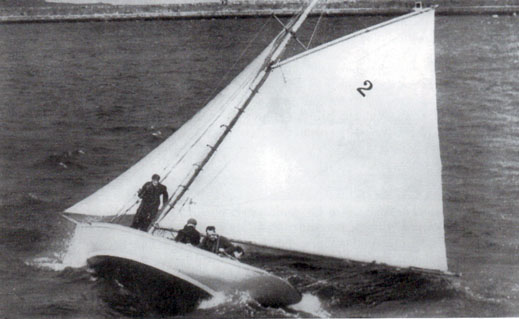
Under shortened rig of full main and jib, but with no tops'l or staysail set, this Dublin Bay 21 in a strong wind is showing marked but controllable weather helm, while the shape of her hull when heeled shows that it is inherently quite well balanced, without excessive fullness of the waterlines aft to distort steering characteristics.
Another topic which came up with the COS brigade (Crusty Old Salts) was the usefulness or otherwise of the topsails. A topsail is only as useful as the quality of its set, and if it isn't perfectly set up to become one with the main, then it can sometimes be worse then useless.
But as our final photo clearly shows, the luff of the Dublin Bay 21s tops'l was actually longer than the luff of the gaff mainsail. And it's the luff length that does the work in going to windward - it's worth remembering that in the great days of gaff rig racing with the big class, the top skippers were so certain of the need for luff length in windward ability that in heavy weather when they reefed the gaff mainsails, they then set up a jib-headed tops'l above the reefed sail in order to maximise luff length within the smaller sail area.
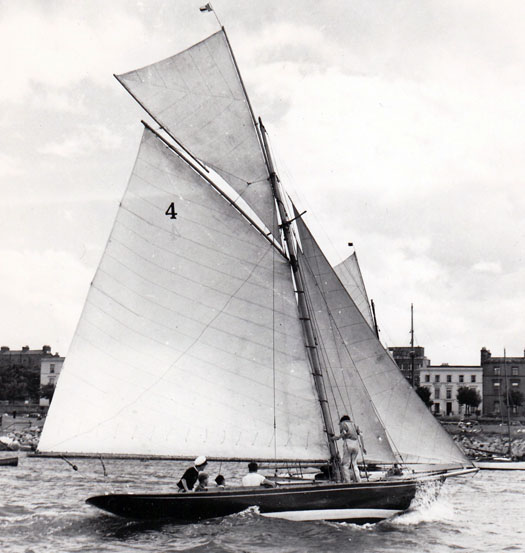
The luff of the jackyard tops'l in a Dublin Bay 21 was slightly longer than the luff length of the mainsail itself, so in sailing to windward, when luff length is at its most important, a well-setting tops'l made a significant difference.
But the problem with a topsail is that if it doesn't click perfectly into place at the first attempt, sometimes it takes for ever to get it right. So with the pace of life becoming more hurried as Ireland entered the 1960s, the time no longer seemed to be available to set up the complete Dublin Bay 21 gaff rig just to go out for an evening race, and the Howth 17s today don't permit topsails for evening club racing.
Back in 1963, when the Dublin Bay 21 crowd were arguing the merits of changing over to Bermuda rig, one of the points in favour of the change was the time it would save. That great sailor and Dublin Bay 21 enthusiast Cass Smullen said this was stuff and nonsense, and claimed he could set up the complete gaff rig of the Dublin Bay 21 in 25 minutes single-handed. So one of the boats was moored just in front of the National YC, and a crowd gathered, drinks in hand, to watch Cass take on the challenge. He did the job in 21 minutes. But they still changed to Bermuda rig.
BIBLICAL EPIC TO IONA
My apologies to Ivan Nelson (see comment at the end of last week's blog – Ed) for the ham-fisted use of English in discussing last week how a Kerry currach – a naomhog from the Dingle Peninsula – came to be sailing to Iona with the first bible in Irish for delivery to the sacred archives there. The bible was of course translated into Irish in 1602 (Old Testament) and again in 1680 (New Testament). We all remember it well. But somehow neither of these translations had ever found its way to Iona, so it was a first in that sense.
Anyway, it's thanks to the crew of Harry Whelehan's 32ft Sea Dancer out of Howth that we got to know of this Kerry voyage, which was done very low key, and in easy stages. Easy stages, that is, if you think it's easy taking a currach all the way up the west coast of Ireland and then past Malin Head and on to Iona.
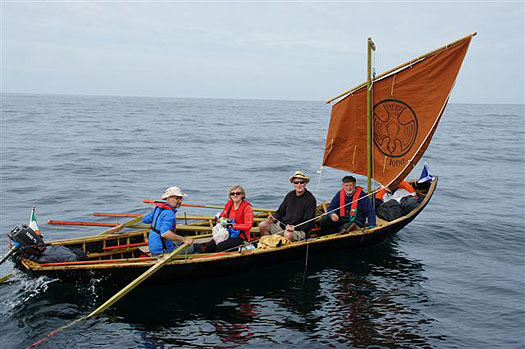
The Kerry currach delivering the Irish bible to Iona last summer completed the voyage in true Christian spirit, with no designated skipper. Photo: Mark Tierney
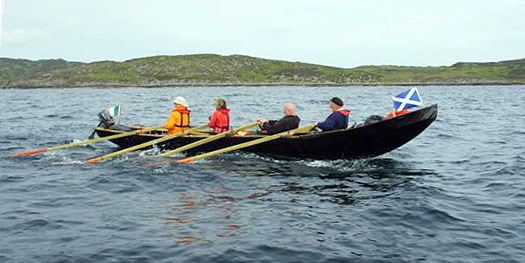
It wasn't all swanning along under sail. In order to get from Ventry to Iona, they often had to pull with a will. Photo: Mark Tierney
The crew of Breanndan Begley, Anne Bourke, Danny Sheehy and Liam Holden did the voyage in three stages over three summers, and in such a spirit of Christian goodwill that the crew of Sea Dancer were unable to tell who if any was the skipper. But the Kerry folk did what they set out to do, then rowed around a few more Scottish islands before heading south, eventually getting to Wicklow. We look forward to hearing about their completion of the circuit of Ireland this summer.
NAOMH BAIRBRE HOME
Thursday nights won't be quite the same now. The six part series on TG4 by Donncha mac Coniomaire and his two shipmates (one of them his father Tomas) about their voyage along the Celtic seaways to Orkney southabout round Ireland from Connemara in the 47ft Galway hooker Naomh Bairbre has come to a successful conclusion. But it certainly shortened the winter watching this demanding ship and her engaging crew making their way to diverse ports which acquired added interest when viewed through the Irish Gaelgoir lens.
Mostly it drew pleasantly to a close as all good cruises do. But there were a few sad moments n the final epiode when they sailed up to Derry to pay their respects to the Galway Hooker An Lady Mor. Donncha had worked in a successful cross-community restoration project on this historic boat back in 2006, and the restoration team then sailed her from the Foyle to Connemara and back when the job was done. But now she lies abandoned and purposeless, ashore in Derry docks, deteriorating rapidly. She could be restored if somebody took action now – I can remember a successful restoration on the same vessel in the mid 1980s by Mick Hunt in Howth. Can't something be done now for An Lady Mor in Derry's year as City of Culture?
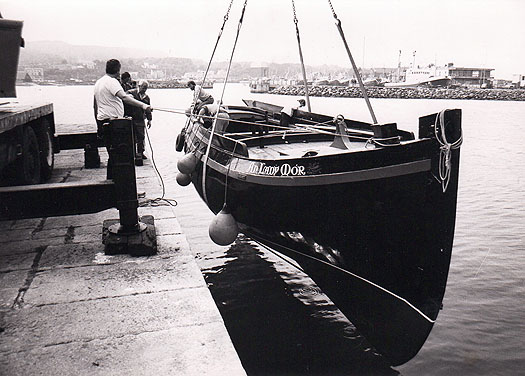
Can she be restored in the City of Culture? An Lady Mor, seen here being launched in Howth in 1985 after restoration by Mick Hunt, is urgently in need of restoration again, this time on the banks of the Foyle. Photo: W M Nixon
Comment on this story?
We'd like to hear from you on any aspect of this blog! Leave a message in the box below or email William Nixon on [email protected]
































































